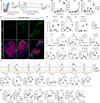Neutrophil-activating therapy for the treatment of cancer
- PMID: 36706760
- PMCID: PMC9968410
- DOI: 10.1016/j.ccell.2023.01.002
Neutrophil-activating therapy for the treatment of cancer
Abstract
Despite their cytotoxic capacity, neutrophils are often co-opted by cancers to promote immunosuppression, tumor growth, and metastasis. Consequently, these cells have received little attention as potential cancer immunotherapeutic agents. Here, we demonstrate in mouse models that neutrophils can be harnessed to induce eradication of tumors and reduce metastatic seeding through the combined actions of tumor necrosis factor, CD40 agonist, and tumor-binding antibody. The same combination activates human neutrophils in vitro, enabling their lysis of human tumor cells. Mechanistically, this therapy induces rapid mobilization and tumor infiltration of neutrophils along with complement activation in tumors. Complement component C5a activates neutrophils to produce leukotriene B4, which stimulates reactive oxygen species production via xanthine oxidase, resulting in oxidative damage and T cell-independent clearance of multiple tumor types. These data establish neutrophils as potent anti-tumor immune mediators and define an inflammatory pathway that can be harnessed to drive neutrophil-mediated eradication of cancer.
Keywords: C5a; CD40; cancer immunotherapy; complement; leukotriene B4; neutrophil; reactive oxygen species; tumor immunology; tumor necrosis factor; xanthine oxidase.
Copyright © 2023 Elsevier Inc. All rights reserved.
Conflict of interest statement
Declaration of interests I.L.L., T.R.P., and E.G.E. are co-inventors on a patent application filed by Stanford University related to this work. W.-C.S. owns equity in, receives a consultant fee and research grant from, and is an inventor of patents licensed to Kira Pharmaceuticals and Aevitas Therapeutics. The other authors declare no competing interests.
Figures








Comment in
-
Firing up neutrophil anti-tumor immunity with cocktails.Cancer Cell. 2023 Feb 13;41(2):227-229. doi: 10.1016/j.ccell.2023.01.005. Cancer Cell. 2023. PMID: 36787693
-
Activated neutrophils: the anti-hero.Nat Rev Cancer. 2023 Apr;23(4):190. doi: 10.1038/s41568-023-00555-9. Nat Rev Cancer. 2023. PMID: 36864183 No abstract available.
References
Publication types
MeSH terms
Substances
Grants and funding
- R01 AI117410/AI/NIAID NIH HHS/United States
- F31 CA196029/CA/NCI NIH HHS/United States
- R01 CA233958/CA/NCI NIH HHS/United States
- R01 AI146162/AI/NIAID NIH HHS/United States
- R01 AI085596/AI/NIAID NIH HHS/United States
- U54 CA209971/CA/NCI NIH HHS/United States
- R01 CA262361/CA/NCI NIH HHS/United States
- F32 CA189408/CA/NCI NIH HHS/United States
- R01 CA222969/CA/NCI NIH HHS/United States
- T32 HL120824/HL/NHLBI NIH HHS/United States
- R01 CA251174/CA/NCI NIH HHS/United States
- P01 CA244114/CA/NCI NIH HHS/United States
- F30 CA196145/CA/NCI NIH HHS/United States
LinkOut - more resources
Full Text Sources
Other Literature Sources
Medical
Molecular Biology Databases
Research Materials

